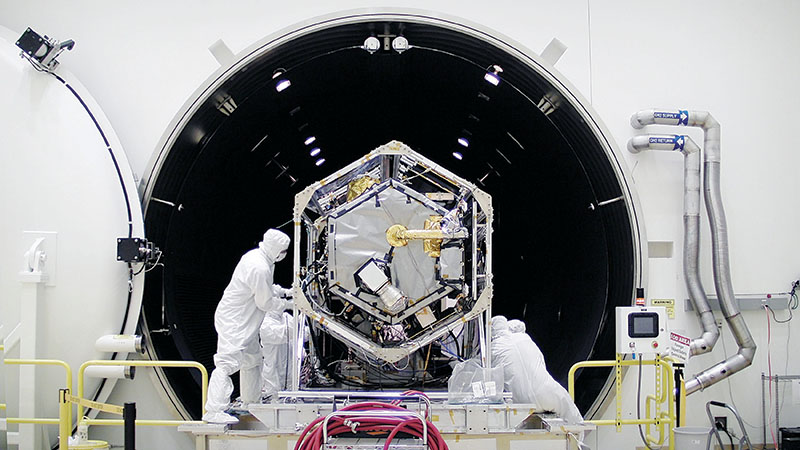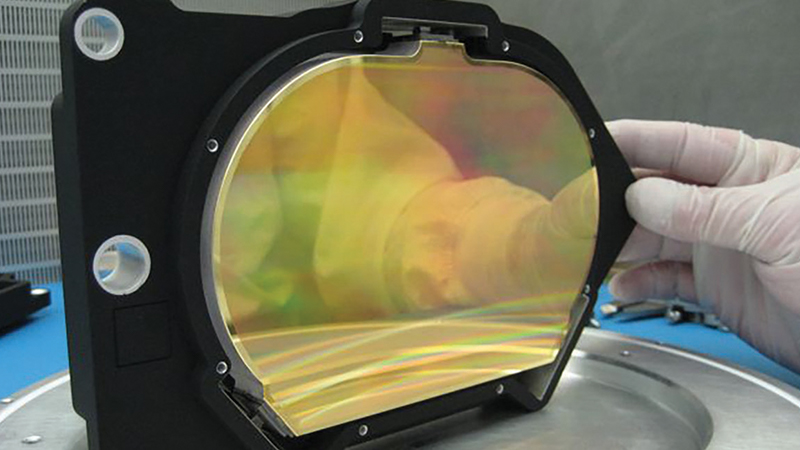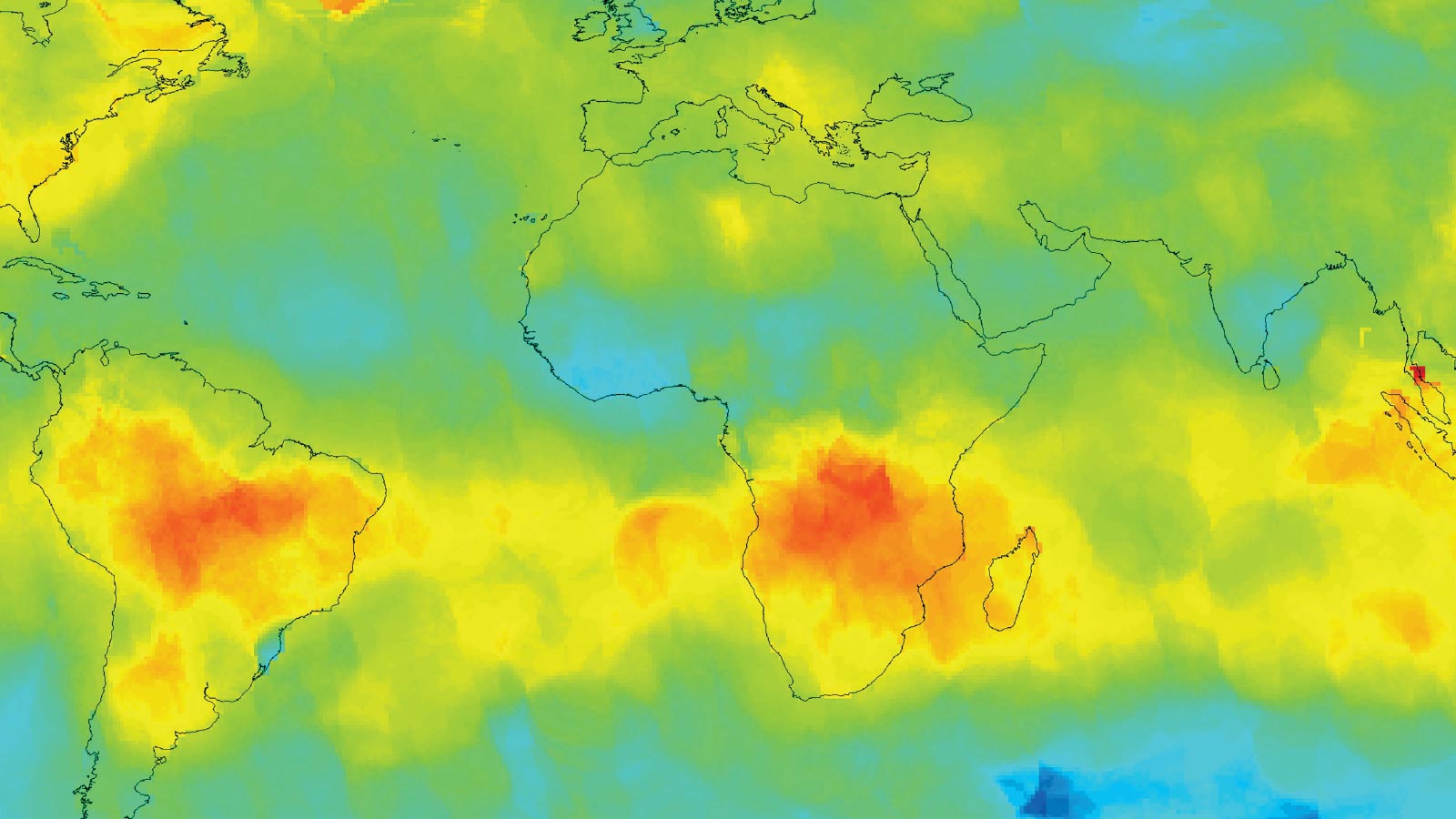Stay Up to Date
Submit your email address to receive the latest industry and Aerospace America news.
Mapping the global distribution of carbon dioxide from orbit
NASA’s Orbiting Carbon Observatory-2 has been circling the globe from pole to pole every 100 minutes for more than two years, gathering sunlight reflected by Earth and bouncing it across reflective surfaces covered with ridges to diffract the light into spectra. Nearly a million daily recordings are downloaded from OCO-2’s three near-infrared spectrometers to show the absorption footprints of gases, including carbon dioxide and oxygen.
These recordings once seemed sure to be the next step toward an international response to climate change in which the world’s worst carbon dioxide emitters would be outed, with their emissions showing up as big orange globs on a global map that would be shared among countries. So far, China and Europe plan to launch carbon-dioxide monitoring satellites; Japan has had one in orbit since 2009; and the International Space Station is even slated to carry one. These readings will be combined with those from spectrometers at ground stations around the globe to gauge the world’s progress in curbing emissions of carbon from burning fossil fuels, forests and crops.
“Over time, remote-sensing data is expected to play an important role in compliance monitoring of commitments made in the Paris Agreement,” says Paul Wennberg, the American scientist who chairs the Total Carbon Column Observing Network, the international scientific partnership that manages the ground sites. The Paris climate accord, supported strongly by Democratic presidential candidate Hillary Clinton, went into force several days before the U.S. presidential election, when an international ratification threshold was met. The agreement aims to reduce greenhouse gas emissions enough to keep the planet from warming more than 2 degrees Celsius over pre-industrial era levels.
Then came the surprise election of Republican Donald Trump. This outcome is raising new questions about whether the U.S. will continue funding climate change research and more satellites like OCO-2 or whether scientists from Europe, Japan and China will have to proceed without the U.S. in their plans to monitor carbon dioxide from space.
Trump’s transition team did not respond to requests for comment, but he has given mixed signals about his views on climate change. In 2012, Trump tweeted that the “concept of global warming was created by and for the Chinese in order to make U.S. manufacturing non-competitive.” During the heat of the Republican primary in South Carolina, he denounced global warming as a “hoax.” In May, he told a North Dakota crowd that he would “cancel the Paris Agreement.” Trump then seemed to reverse himself after the election, telling reporters and editors from the New York Times that “there is some connectivity” between humans and climate change, that “clean air is vitally important” and that he would keep an “open mind” on the international emissions agreement. Advocates of the multinational agreement are far from certain, however, about the incoming administration’s final stance on policies to address climate change.
International effort
What is certain is that multiple satellites are needed for a more comprehensive map of carbon dioxide in the atmosphere, and that is starting to happen. China was planning to launch its TanSat last month to measure carbon dioxide with a near-infrared spectrometer, says Liu Yi, who is the team leader of the satellite project. Liu says the Chinese Academy of Sciences “plans to sign cooperation agreements soon” to share the TanSat’s maps of carbon dioxide sinks and emissions with Wennberg’s Total Carbon Column Observing Network. This year, scientists expect the European Commission to ask the European Space Agency to build a carbon-dioxide monitoring satellite likely to be called Sentinel-7. It would be constructed under Europe’s Copernicus climate data initiative for launch in 2024 or 2025. Japan led the way on carbon-dioxide monitoring when it launched its Greenhouse Gases Observing Satellite, or GOSAT, in 2009. The Japan Aerospace Exploration Agency plans to launch GOSAT-2 between April 2018 and March 2019 to measure carbon dioxide, methane and carbon monoxide.
One satellite can’t do it all. To get its high-resolution readings, OCO-2 measures a swath that is about 10 kilometers wide for each orbit, which means it covers only about 7 percent of the atmosphere each month. Only 10 percent of the nearly 1 million measurements it captures each day are free of disturbances that interfere with its data collection, including clouds that prevent sunlight from reaching the surface. More satellites like OCO-2 would close those gaps and improve the odds of collecting cloud-free data at a specific location. It would then be possible to pinpoint which factories, cities and coal mines in different countries spew the most carbon dioxide, says David Crisp, an atmospheric physicist at the NASA-funded Jet Propulsion Laboratory in California, who led the design of the OCO-2 spectrometer.
The ground spectrometers operated by Wennberg’s group don’t have to collect data while rapidly orbiting the planet, so they can collect more sensitive measurements than those on existing satellites. The drawback of ground-based spectrometers is that they provide soda-straw views of the atmosphere from fixed locations. Scientists want to expand this coverage by adding the view from multiple satellites like OCO-2. Even with the OCO-2 data, today’s carbon dioxide maps are rudimentary.
“These maps do not yet have the precision, accuracy, resolution or coverage needed by policymakers,” Crisp says. “We are a long way from that goal.”
Advocates say the idea can work without the U.S. but that it would be much harder.
“Many hands make for lighter work,” Crisp says.
Scientists want to measure carbon dioxide more frequently because the emissions dissipate from their original source or become corrupted by the presence of aerosol, water vapor or other gases.
“Monitoring is knowing. As such, it is in the interest of any modern society and [should] not be seen as a partisan issue,” says Guido Levrini, the Italian program manager with ESA’s Copernicus initiative. “Space is the only way to get real global coverage and a uniform, calibrated way of measuring air pollution. It will establish the facts of how much pollution is coming from different nations.”
Aside from pinpointing emissions, mapping carbon dioxide could help scientists identify the species of trees and characteristics of the oceans that do the best job of cleansing the atmosphere of carbon. These areas are called carbon sinks because they absorb more carbon dioxide than is emitted from naturally decaying or burning organic matter. Many questions have yet to be answered by research into carbon sinks. Oceans are a special concern, given that two-thirds of Earth is covered by them. Scientists don’t fully understand how oceans absorb carbon dioxide, and the effectiveness of forests and biospheres around the equator is a particular unknown because of lack of research in those regions.
“We don’t know how long the natural process will continue to absorb carbon dioxide as the oceans warm,” Crisp says. “This information is critical to help manage carbon dioxide in the future.”
The view in Congress
Even before the presidential election, advocates of satellites like OCO-2 hoped for bipartisan support. Even some in Congress who doubt that human activities are responsible for the bulk of the warming have argued that continued studies of the climate were necessary before reaching policy conclusions.
Among the doubters is Republican Rep. John Culberson of Texas, chairman of the House subcommittee responsible for science appropriations. He says that naturally occurring variables in addition to humans could be warming the planet, including ocean currents that he says have shifted and affected the climate numerous times. Culberson notes that carbon dioxide levels in the atmosphere were higher during other eras of history, including the Cretaceous Period nearly 66 million years ago.
“I am not aware that the dinosaurs had any problems with industrial pollution,” he says.
Despite Culberson’s reservations about humanity’s role in the warming, he wants to fund NASA “at record levels to ensure they can do everything on their plate without sacrificing any part of its essential mission.” Culberson isn’t saying whether that should include a new satellite like OCO-2, but he says he recognizes the value of the data it collects. “We need to understand the effectiveness of carbon sinks that are a natural part of the carbon cycle on Earth,” he says, especially ocean plankton and rainforests.
Other Republicans have already made up their minds. One of them is Rep. Dana Rohrabacher, R-California, vice chairman of the House committee responsible for authorizing science expenditures. His chief of staff, Rick Dykema, says in an email that the congressman would not support a new generation of NASA satellites to track greenhouse gas emissions.
“He does not believe that such a function is within
the proper role of our space exploration agency,” Dykema says. “Congressman Rohrabacher does not support the Paris Agreement. He does not believe that it is legally binding on the U.S.”
If the incoming Trump administration and Congress follow tradition, they are likely to shape their position on carbon-dioxide monitoring satellites based on whether the next decadal survey of the National Academies of Sciences, Engineering, and Medicine recommends launching new ones to continue the mission started by OCO-2. The academy expects to release the “Decadal Survey for Earth Science and Applications From Space” in late 2017.
Congress “leans heavily” toward these recommendations but must do so with a budgeteer’s eye, says Republican Rep. Lamar Smith of Texas, a climate change doubter and chairman of the House science committee for which Rohrabacher is vice chairman. Smith says he would review any proposal to fund a new satellite based on whether NASA could instead rely on data collected by other nations.
“Members would have to conduct a cost-benefit analysis for the incremental capability derived from that data,” Smith says.
Commenting on the election results, Smith says he looks forward to working with the Trump administration on environmental and energy policies “to ensure that decisions are based on sound science and transparency for the American people.” Smith had criticized the Obama administration’s support for the Paris Agreement as based on “science fiction.”
The chairman has in recent years supported budgets for NASA’s Earth Science Division that were smaller than those sought by the White House, with the aim of moderating its growth compared with the agency’s other divisions. Smith is among Republicans who have said measuring carbon dioxide emissions raises questions about the appropriate role of NASA and whether NOAA should manage that Earth science data instead.
Crisp says it is “business as usual” for NASA to collect environmental data from space to help inform policymakers. Bill Townsend, former deputy director at NASA’s Goddard Space Flight Center in Maryland, also says shifting that responsibility from NASA to NOAA would be a bad idea because the atmospheric research agency “already has a full plate” and would likewise have a difficult time securing funds for climate change research.
Rep. Eddie Bernice Johnson of Texas, the ranking Democrat on the House science committee, stresses the value of carbon dioxide monitoring and the Paris Agreement and says she cannot predict how the incoming administration will approach these initiatives.
“I sincerely hope that we can continue to work to better understand our planet, the role that climate plays and how to mitigate the harmful effects of climate change,” Johnson says.
Townsend, an industry consultant since leaving NASA in 2004, predicts difficulty ahead for those who advocate more missions like OCO-2. “Anything closely tied to climate change is likely to have a very hard time of it for the next four years in terms of sustaining funding for what’s already being built and especially for starting anything new,” he says. That said, “International collaboration, where the U.S. cost is substantially reduced, seems to frequently carry the day,” he adds. “Climate change is a global problem that needs a global solution.”
The OCO satellite team has overcome challenges before. NASA, facing a funding crunch, was forced to temporarily halt planning toward affixing OCO-2’s spare science instrument onto the outside of the International Space Station. This mission, called OCO-3, was revived at the end of 2015 because of expanded funds approved by Congress for fiscal 2016, and the instrument is now due for installation in 2018. Then there was the fate of OCO-2’s predecessor. It crashed into the ocean near Antarctica in 2009 before reaching orbit, because the fairing shell that protected it during its launch on a Taurus XL rocket failed to jettison.
Today’s political situation will be a challenge of a different sort.
INFAMOUS RECORD
The World Meteorological Organization announced in October that the global average concentration of carbon dioxide in the atmosphere in 2015 reached 400 parts per million, which is the highest in recorded history.
"Monitoring is knowing. As such, it is in the interest of any modern society and [should] not be seen as a partisan issue."
Guido Levrini of the European Space Agency
About Tom Risen
As our staff reporter from 2017-2018, Tom covered breaking news and wrote features. He has reported for U.S. News & World Report, Slate and Atlantic Media.
Related Posts
Stay Up to Date
Submit your email address to receive the latest industry and Aerospace America news.






